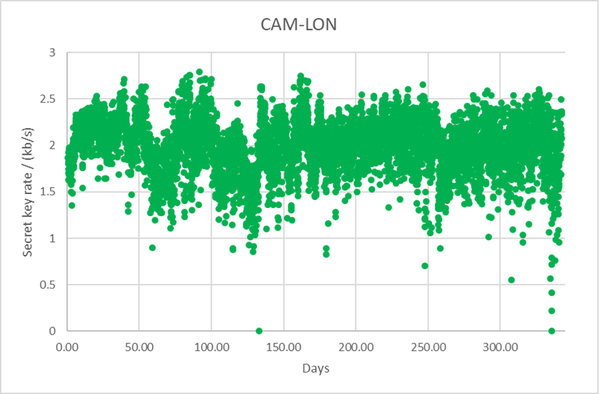
Case study: UK Quantum Network
The UK Quantum Network has successfully connected Cambridge with Bristol with secure key rates of at least 1kb/s over links with optical losses of up to 28dB.
The principal objective of the UK Quantum Network is to connect two major quantum communications research networks at Cambridge and Bristol and allow onward connectivity to BT labs at Adastral Park via the UKQNTel (connecting Cambridge and Adastral Park)
Connectivity between Cambridge and Bristol is achieved by using QKD equipment procured from Toshiba over the NDFF links between Cambridge and London, London and Reading, Reading and Froxfield (near Hungerford) and Froxfield to Bradley Stoke (in north Bristol). The final link between Bradley Stoke and Bristol University is provided by the University of Bristol.
There have been challenges associated with the need to operate the fibre on a time shared basis. These have now been resolved with the provision of two fibre pairs over all routes within the network, allowing continuous operation over extended periods to be anticipated.

Figure 1: Graphical summary of the performance of the UK Quantum Network between Cambridge and Bradley Stoke.
In addition to the QKD systems, deployment of lightweight key management standards compliant key management (ETSI GS QKD 014) services is currently underway, enabling end-to-end quantum secured communication to be made available to a variety of classical communication services. The facility will include the capability of combining QKD with post-quantum cryptography, to provide a robust hybrid encryption solution.
A brief summary of the operational characteristics of the UKQN is shown in Table 1. It can be seen that link lengths vary between 51 and 128 km, with optical losses between 11 and 28dB encountered. The end-to-end secure key rate of more than 1kb/s is dictated by the lowest rate link, between Reading and Telehouse, which initial measurements indicate operates at 1.5kb/s.
Table 1. Summary performance data for the UKQN
|
Start |
End |
Distance / km |
Loss / dB |
QBER / % |
Secure KR / kbs-1 |
|
Cambridge |
Telehouse |
128 |
28 |
5.9 ± 0.2 |
2.0 ± 0.3 |
|
Telehouse |
Reading |
112 |
24 |
5.8 ± 0.2 |
1.5 ± 0.2 |
|
Reading |
Froxfield |
51 |
11 |
4.3 ± 0.2 |
10.6 ± 1.9 |
|
Froxfield |
Bradley Stoke |
95 |
20 |
4.7 ± 0.3 |
6.3 ± 1.8 |
The current deployment of concurrent high data rate optical communications is limited to the most challenging 128km link between Cambridge and London by equipment availability, though it is hoped to increase the scope of this in the future. The Cambridge to London link has operated continuously with 100Gb/s co-existing classical traffic for nearly a year, achieving a secure key rate of 2.0 ± 0.3 kb/s with a quantum bit error rate of 5.9 ± 0.2%, this is illustrated in Figure 2.

Figure 2: 345 days continuous operation of the Cambridge to London Quantum link over 128km with 28dB optical loss. This link achieves a secure key rate of 2.0 ± 0.3 kb/s in the presence of 100Gb/s of classical data traffic.
Funding information: This work has been funded by The EPSRC Quantum Communications Hub, (EP/T001011/1).
For further information: contact Dr. Adrian Wonfor, ndff@ee.ucl.ac.uk
Published: 07 June 2024
